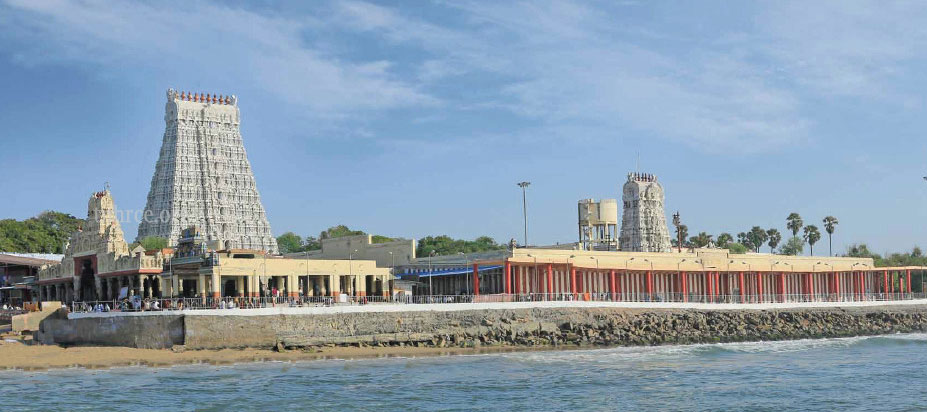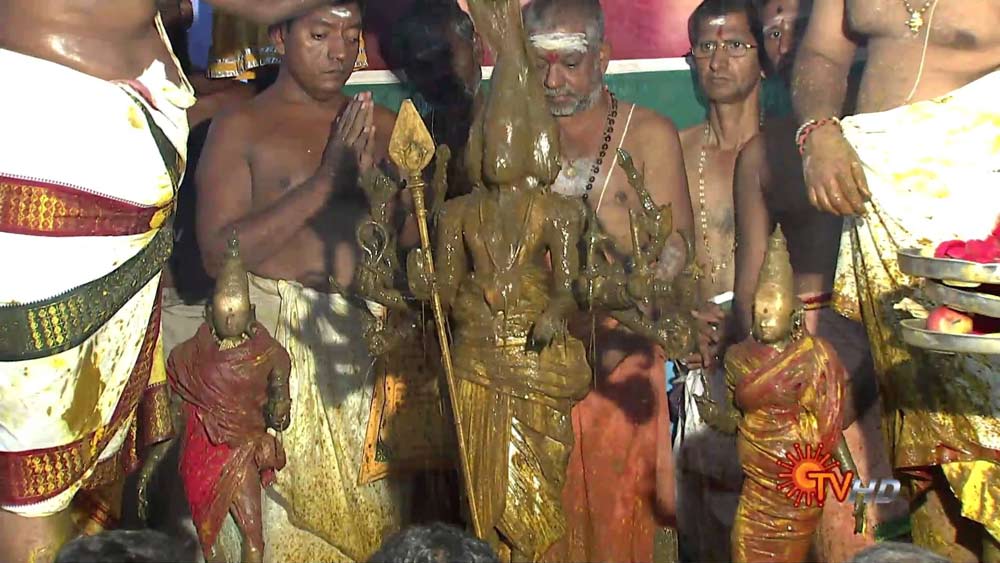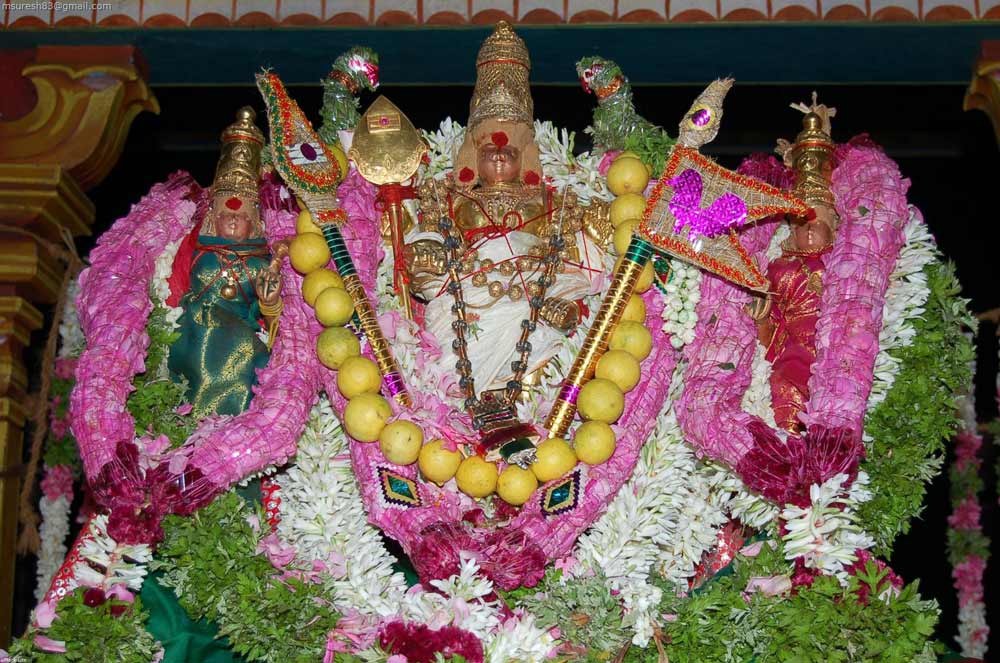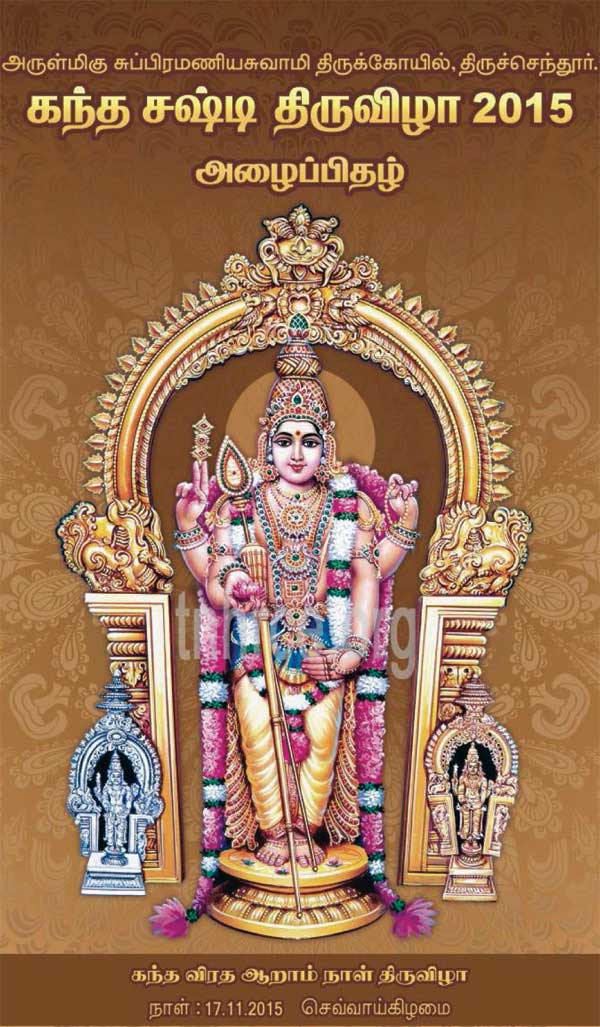
|
||||||||||
|
| ||||||||||
Arulmigu Subrahmanya Swami Tirukkovil
Tiruchendur, Tuticorin DistrictIn most Murugan temples, Kanda Ṣaṣṭi festival is celebrated for six days only. In some temples it is celebrated for seven days, with the divine wedding of Lord Murugan the day after Ṣaṣṭi. But in Tiruchendur the festival is held for twelve days; the first six days of Kanda Ṣaṣṭi comprise Ṣaṣṭi vratam (the vow of Ṣaṣṭi) and Sūra Samhāram (the annihilation of the demon, Sūra), on the seventh day it is the divine wedding of Lord Murugan and Teyvānai, and in the next five days, the Lord in His wedding gear appears and blesses in the Unjal Sevai that is, sitting on the swing. Offerings to Lord Murugan: Lord Murugan won and accepted Sūrapadman on Ṣaṣṭi (sixth day) of the waxing moon (bright) night (valar pirai) of the month Aippasi. This day is celebrated as Kanda Ṣaṣṭi. This incident happened at Tiruchendur and hence, the Kanda Ṣaṣṭi festival is calebrated in this place with all grandeur. In the Kanda Purana of Mahābhārata, two other causes are indicated for the celebration of Kanda Ṣaṣṭi festival, apart from the extermination of Sūrapadman. Once a few sages conducted a yāga (sacred fire worship) with a behest to get a son for the welfare of the world. It was begun on the New Moon day and went on for six days. From the fire erupted out of the sacrificial altar (yāga kundam), six seeds – one seed each day for six days respectively – were collected. Lord Murugan was born on the sixth day, when all these six seeds were made as one. The Mahābhārata asserts that the day of the birth of Lord Murugan is the Kanda Ṣaṣṭi Day. In the Kanda Purana, Kachiappa Sivāchāriyar says that the Devas, in order to become powerful to challenge the asuras, carried on a vow by soliciting Lord Murugan to be in the kumbham (sacred pot) for six days. Lord Murugan blessed them likewise. This incident is remembered as Kanda Ṣaṣṭi and celebrated after Aippasi New Moon day – so says Sivāchāriyar. Ṣaṣṭi Yāgam: 
Abhishekam to the Mirror: On the next day that is on the seventh day, the holy wedding of Lord Murugan and Teyvānai is performed. Lord Indra not only gives Teyvānai in marriage to Lord Murugan for having defeated the asura but also renders service by becoming the holy peacock. This marriage happens at Tirupparankundram, the first Patai Veetu. At Tiruchendur, the holy wedding between Lord Murugan and Teyvānai is performed on the next day to Kanda Ṣaṣṭi since it is the place where Sūrapadman is vanquished. During the morning of that day, Teyvānai goes to the Tapasu Mandapam and will do her tapasya to get married to Lord Murugan. In the evening Kumāra Vitankar (another Utsava murthi), representing Lord Murugan goes to the Tapasu Mandapam seated on His peacock vehicle, garlands Teyvānai and gets engaged. Towards midnight, both reach the Tirukalyāna Mandapam. There the wedding is performed. The next day, the Lord with Teyvānai goes in street procession. The next three days the Lord in the Tirukalyāna Mandapam will be on the oonjal (swing) and bless the devotees. 
Turmeric Bath (manjal neerātu) for Lord Murugan: Triple Lord Murugan: On the evening of the seventh day of the festival, He is adorned with red dress and appears as Lord Siva. At the dawn of the 8th day, He is dressed in white and graces us in the form of Lord Brahma and during the noon He appears in green dress signifying Lord Vishnu. At Tiruchendur, the Rajagopuram is on the western side of Lord Murugan’s sanctum. Here, Lord Murugan faces east looking at the sea. The Rajagopuram should be opposite to the Lord in the east; since the sea is there in the east, the Rajagopuram is erected in the west. As the threshold of this gopuram is higher than the rostrum (peetam) of the prime sanctum of Lord Murugan, it remains always shut. During the Kanda Ṣaṣṭi festival in the midnight of the Divine Wedding day, this door will be opened. At that time, however, the devotees will not be allowed to enter through that door. Four Utsava Murthis: 
Sandana Malai (Sandal Hill): Go here for Guru Peyarcchi (moving of Jupiter planet): At Tiruchendur, Lord Murugan appears as Gnāna Guru. In this sacred place, Guru Bhagawan narrated the history of the asuras to Lord Murugan, before the Lord vanquished them. Hence, this holy place is considered as the Holy Place of Guru. Médha Dakshinamurthi in the paved corridor is seen sitting on four different seats, namely Koormam (tortoise), the Eight Serpents (Ashta Nākankal), the Eight Elephants (Ashta Gajās) and the Médha Malai (Wisdom Hill). On His rear side is the stone banyan tree on which are perched the four Vedas in the form of parrots. As He graces with knowledge and wisdom, He is called as Gnānaskanda Murthi. Generally, Dakshinamurti is seen with fire and utukkai (small drum tapering in the middle) in the hands; here He appears with mān and mallu (antelope and axe-like weapon). Worshipping Tiruchendur Murugan on the Guru Peyarcchi day will ward off the ill effects caused by the planet Jupiter. Two Murugans: Procession with new Deepavali Dress: We all happily celebrate Deepāvali -- the day when Lord Vishnu annihilated Narakāsura -- by wearing new dresses. In the Tiruchendur temple also all deities are adorned with new dresses on the Deepāvali day. At dawn, all the retinue gods of this temple are smeared with sandal paste. Then the new dresses are carried in the silver palanquin in a procession and the deities are decked with them. It is believed that since this place where Lord Murugan wedded Teyvānai, Lord Indra gifts new dresses to his son-in-law and His retinue for Deepavali. Darshan of Pancha Lingam: Ganga Pooja: The Devas made a complaint to Lord Siva to put an end to Sūrapadman who was oppressing them. Accepting their plea, Lord Siva from His third eye created six fire-sparks. Lord Murugan was born from that. Later, obeying Lord Sivas order, He came here to remove Sūrapadman. At this time, Guru Bhagawan, the Preceptor of the Devas, was in tapasya in this place praying for the darshan of Lord Murugan, Who appeared before him and stayed here. Through Guru Bhagawan He also learnt the history of the asuras. He sent as messenger His commander-in-chief, Veerabāhu to Sūrapadman, but he refused to listen to Lord Murugan’s words. Later the Lord went with His battalion and killed him. Guru Bhagawan requested the Lord to remain in this place where he had the Lord’s darshan. At the behest of Guru, the Lord continued to be here. Guru Bhagawan soon after called Viswakarma the divine Architect to erect the temple. Lord Murugan was called Jayanti Nāthar since he routed Sūrapadman. After a while, this name became Senthil Nāthar. The place was also called Tirujayantipuram (jayanti or victory) and in due course became Tiruchendur. Source: Dinamalar.com For more pictures of Kanda Sasti, go to Kanda Sasti 2011 picture gallery.
|
